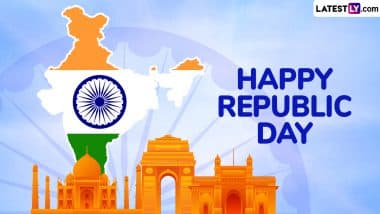The Indian Constitution is a remarkable document that serves as the cornerstone of India’s democracy, guiding its laws, governance, and rights. It not only lays down the legal framework but also shapes the ethos of the Indian republic. The Constitution of India was adopted by the Constituent Assembly on November 26, 1949. And it was on January 26, 1950, when the Constitution of India came into force. To commemorate the significant day, the country celebrates Republic Day, also known as Gantantra Diwas. As we celebrate the 76th Republic Day, here are some fascinating facts about the Constitution that highlight its uniqueness and significance. Republic Day Parade 2025 Date, Time and Live Streaming.
1. Longest Written Constitution in the World
The Indian Constitution is the longest written constitution globally, with over 450 articles divided into 25 parts, 12 schedules, and 100 amendments. It has been a comprehensive document, catering to the complex needs of a diverse nation like India. Republic Day 2025 Wishes and Greetings.
2. Inspired by Multiple Sources
The Indian Constitution draws inspiration from various sources, including the British Parliament, the US Constitution, and the Irish Constitution. It blends these elements to create a system that best suits India’s unique needs and cultural context.
3. Adopted on November 26, 1949
India’s Constitution was adopted by the Constituent Assembly on November 26, 1949, but it came into effect on January 26, 1950—celebrated as Republic Day. This date was chosen to honor the significance of the 1930 Lahore Declaration, which called for complete independence from British rule.
4. Bilingual Document
While the original Constitution was drafted in English, it also includes a Hindi version, making it the first bilingual constitution in the world. The use of both languages ensures accessibility and clarity for a diverse population.
5. Federal Structure with Unitary Bias
The Constitution of India establishes a federal structure, with a division of powers between the central and state governments. However, it leans towards a unitary system during emergencies, giving more powers to the central government when necessary.
6. Fundamental Rights and Duties
The Constitution not only guarantees Fundamental Rights to Indian citizens (like freedom of speech, right to equality, etc.) but also outlines Fundamental Duties. The latter remind citizens of their responsibilities toward the nation and society.
7. Unique Amendability
The Indian Constitution is known for its flexibility. It can be amended to address changing societal and political needs. The procedure for amendment is detailed, but it allows the Constitution to evolve over time, making it a living document.
8. The President’s Role
Unlike most countries, India’s President is both the head of state and the formal head of the executive. However, the real power lies with the Prime Minister and the Cabinet, making the position largely ceremonial.
India’s Constitution is a remarkable reflection of the country’s democratic values, flexibility, and commitment to justice.
(The above story first appeared on LatestLY on Jan 26, 2025 07:51 AM IST. For more news and updates on politics, world, sports, entertainment and lifestyle, log on to our website latestly.com).













 Quickly
Quickly
























